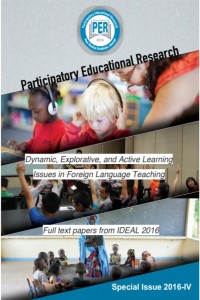Research Article
Year 2017,
Volume: 4 Issue: 2, 212 - 220, 01.12.2017
Abstract
References
- Bach, S., Haynes, P. & Smith, J.L. (2007). Online Learning and Teaching in Higher Education. USA: Open University Press.
- Borotis, S., Zaharias, P. & Poulymenakou, A.( 2008). Critical Success Factors for E-learning Adoption. In T. T. Kidd & H. Song (Eds.), Handbook of Research on Instructional Systems and Technology (pp. 498s-514). NewYork: Information Science Reference, IGI Global.
- Chinaza, N. K., Chimezie, B. A., Juliana, A. & Efeyaelu, U.H. (2015). Computer Self-efficacy, Computer-related Technology Dependence and On-line Learning Readiness of Undergraduate Students. International Journal of Higher Education Management, 1(2), 60-71.
- Cinkara, E., Bagceci, B. (2013). Learners' Attitudes towards Online Language Learning; and Correspponding Success Rates. The Turkish Online Journal of Distance Education, 14(2), 118-128.
- Deveci Topal, A. (2016). Examination of University Students' Level of Satisfaction and Readiness for E-courses and the Relationship between Them. European Journal of Contemporary Education, 15(1), 7-23.
- Garrison, D. R. (2005). Quality and Access in Distance Education: Theoretical Considerations. In D. Keegan (Ed.), Theoretical Principles of Distance Education (pp. 8-19). NewYork: Routledge.
- Harasim, L. (2000). Shift Happens: Online Education as a New Paradigm in Learning. Internet and Higher Education, 3(1), 41-61.
- Hung, M.L., Chou, C., Chen, C.H., & Own, Z.Y. (2010). Learner Readiness for Online Learning: Scale Development and Student Perceptions. Computers & Education, 55, 1080-1090.
- İlhan, M., Çetin, B. (2013). Çevrimiçi Öğrenmeye Yönelik Hazır Bulunuşluk Ölçeği'nin (ÇÖHBÖ) Türkçe Formunun Geçerlik ve Güvenirlik Çalışması. Eğitim Teknolojisi Kuram ve Uygulama, 3(2), 72-101.
- Kerr, M.S., Rynearson, K. & Kerr, M.C. (2006). Student Characteristics for Online Learning Success. Internet and Higher Education 9, 91-105.
- Kırmızı, Ö. (2015). The Influence of Learner Readiness on Student Satisfaction and Academic Achievement in an Online Program at Higher Education. The Turkish Online Journal of Educational Technology, 14(1), 133-142.
- Ko, S. Rossen, S. (2010). Teaching Online: A Practical Guide. NewYork: Routledge.
- Marks, D. B. (2016). Theory to Practice:Quality Instruction in Online Learning Environment. National Teacher Education Journal, 9(2), 75-79.
- Roach, V. & Lemasters, L. Satisfaction with Online Learning: A Comparative Descriptive Study. Journal of Interactive Online Learning, 5(3), 317-332.
- Rosenberg, M. J. (2001). E-learning: Strategies for Delivering Knowledge in the Digital Age. NewYork: McGraw-Hill.
- Smulders, D. (2003). Designing for Learners, Designing for Users. eLearn Magazine. Retrieved from http://elearnmag.acm.org/archive.cfm?aid=2134466.
- Yin, R. (1994).Case Study Research: Design and Methods. USA: SagePublication.
Year 2017,
Volume: 4 Issue: 2, 212 - 220, 01.12.2017
Abstract
The purpose of this study is to find out online
learning readiness level of medical students at a university in the
northeastern part of Turkey. As a part of a program development process with a
focus on online Medical English, the researcher aimed to determine medical
students' online learning readiness level. To this end, Turkish version of
Online Learning Readiness Scale (OLRS) was employed [original version by Hung,
Chou, Chen and Own (2010) and Turkish version by İlhan and Çetin (2013)]. A
total of 189 students completed the scale. The overall results suggest that once
the internet and computer self-efficacy of the participants are improved, they
appear to be ready for the adoption of online learning.
References
- Bach, S., Haynes, P. & Smith, J.L. (2007). Online Learning and Teaching in Higher Education. USA: Open University Press.
- Borotis, S., Zaharias, P. & Poulymenakou, A.( 2008). Critical Success Factors for E-learning Adoption. In T. T. Kidd & H. Song (Eds.), Handbook of Research on Instructional Systems and Technology (pp. 498s-514). NewYork: Information Science Reference, IGI Global.
- Chinaza, N. K., Chimezie, B. A., Juliana, A. & Efeyaelu, U.H. (2015). Computer Self-efficacy, Computer-related Technology Dependence and On-line Learning Readiness of Undergraduate Students. International Journal of Higher Education Management, 1(2), 60-71.
- Cinkara, E., Bagceci, B. (2013). Learners' Attitudes towards Online Language Learning; and Correspponding Success Rates. The Turkish Online Journal of Distance Education, 14(2), 118-128.
- Deveci Topal, A. (2016). Examination of University Students' Level of Satisfaction and Readiness for E-courses and the Relationship between Them. European Journal of Contemporary Education, 15(1), 7-23.
- Garrison, D. R. (2005). Quality and Access in Distance Education: Theoretical Considerations. In D. Keegan (Ed.), Theoretical Principles of Distance Education (pp. 8-19). NewYork: Routledge.
- Harasim, L. (2000). Shift Happens: Online Education as a New Paradigm in Learning. Internet and Higher Education, 3(1), 41-61.
- Hung, M.L., Chou, C., Chen, C.H., & Own, Z.Y. (2010). Learner Readiness for Online Learning: Scale Development and Student Perceptions. Computers & Education, 55, 1080-1090.
- İlhan, M., Çetin, B. (2013). Çevrimiçi Öğrenmeye Yönelik Hazır Bulunuşluk Ölçeği'nin (ÇÖHBÖ) Türkçe Formunun Geçerlik ve Güvenirlik Çalışması. Eğitim Teknolojisi Kuram ve Uygulama, 3(2), 72-101.
- Kerr, M.S., Rynearson, K. & Kerr, M.C. (2006). Student Characteristics for Online Learning Success. Internet and Higher Education 9, 91-105.
- Kırmızı, Ö. (2015). The Influence of Learner Readiness on Student Satisfaction and Academic Achievement in an Online Program at Higher Education. The Turkish Online Journal of Educational Technology, 14(1), 133-142.
- Ko, S. Rossen, S. (2010). Teaching Online: A Practical Guide. NewYork: Routledge.
- Marks, D. B. (2016). Theory to Practice:Quality Instruction in Online Learning Environment. National Teacher Education Journal, 9(2), 75-79.
- Roach, V. & Lemasters, L. Satisfaction with Online Learning: A Comparative Descriptive Study. Journal of Interactive Online Learning, 5(3), 317-332.
- Rosenberg, M. J. (2001). E-learning: Strategies for Delivering Knowledge in the Digital Age. NewYork: McGraw-Hill.
- Smulders, D. (2003). Designing for Learners, Designing for Users. eLearn Magazine. Retrieved from http://elearnmag.acm.org/archive.cfm?aid=2134466.
- Yin, R. (1994).Case Study Research: Design and Methods. USA: SagePublication.
There are 17 citations in total.
Details
| Primary Language | English |
|---|---|
| Subjects | Studies on Education |
| Journal Section | Research Articles |
| Authors | |
| Publication Date | December 1, 2017 |
| Acceptance Date | November 30, 2016 |
| Published in Issue | Year 2017 Volume: 4 Issue: 2 |



